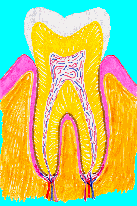
Tooth Decay
Dental Emergencies
Crowns
|
|
|
My Dental Practice Tooth Decay Dental Emergencies Crowns |

| 1. Healthy gums, no plaque or bleeding. Light pink appearance, no treatment needed. Good bone levels and chewing ability. |

| 2. After a few hours without brushing, plaque bacteria start to build up on the surface of the teeth and gums to form a thin slimy whitish layer. The gums are still light pink and healthy. |

| 3. After a day or so the plaque becomes thicker and more yellowish in appearance, and the gums start to develop some inflammation. At this stage what is required is thorough brushing and flossing to return to a state of healthy plaque free gums. |

| 4.After a few days without brushing the plaque layer becomes much thicker and the gums start to swell. The gums have a more reddish appearance, and as they swell the tips of the gums come away from the surface of the teeth to produce a so called "false" pocket. This situation is reversible by regular thorough brushing and flossing. The gums may bleed on brushing at this stage. |

| 5. After a while, if the plaque continues to rest on the surface of the gum, then it starts to burrow between the tooth and gum margin to produce a true pocket. This is the start of true gum disease and is when bone loss around the tooth begins to occur. Foul tastes and smells may also start at this stage. Professional scaling will help to return the gums to a more healthy state, in addition to improved brushing and flossing. |

| 6. The process begun in stage 5 continues, and as the bone is lost, the inflamed gums also start to recede around the necks of the teeth. The exposed root surface (dentine) may start to become sensitive. At this stage professional scaling followed by a period of thorough brushing and flossing is required to bring the gums back to a state of health. A toothpaste such as Sensodyne, Macleans Sensitve, or Colgate Sensitive may help reduce root surface sensitivity to hot, cold and sweet things. |

| 7. At some point in time, maybe many years from when gum disease started causing bone loss, a particularly virulent strain of bacteria will start to invade into the gum and surrounding bone to produce a "gum boil" type of infection. The abscessed gum beomes very swollen, and there is often pain on biting. Antibiotics are often needed at this stage. This is the first time that the gum disease process will cause pain and inconvenience to the individual, but as the diagram shows, the tooth has already lost a great deal of bone support. Discing the affected tooth/teeth, and possibly any opposing teeth, so that the person can bite down without hitting the affected tooth/teeth could also ease matters considerably in the short term. |

| 8. The acute abscess of stage 7 may be followed by a much less painful chronic phase where the bone continues to be lost. The gum remains inflamed, and pus exudes from the pocket from time to time. Scaling, improved oral hygiene and possibly gum surgery may be needed to save the tooth. To guarantee no further pain the tooth may need to be extracted. Unless the patient improves their oral hygiene further painful acute gum infections are likely. The gums at this stage are deep reddish, bleed very easily and the tooth starts to feel looser. |

| 9. If left unchecked the gum disease can continue to progress and engulf the tip of one or more roots of the tooth. The gums recede to the point where the roots diverge and it becomes virtually impossible to keep the tooth plaque free. Hemisection of the infected root, together with a root filling may enable part of the tooth to be saved, but tooth extraction is most often done at this stage. |

| 10. By this time the tooth is very loose and useless for chewing with. It has come to the end of it`s useful life, and moves up and down in it`s socket as well as from side to side. If it is not extracted it may go on to stage 11, and fall out. It can be very painful at this stage. |

| 11. At some point a very loose tooth will exfoliate, possibly on chewing something slightly harder than normal, or just catching the tooth in an awkward manner. The socket will usually bleed, but once the tooth has fallen out any pain is likely to be minimal. |

| 12. The bone and gum that once supported the tooth will remodel after a few months to form a smooth ridge. |